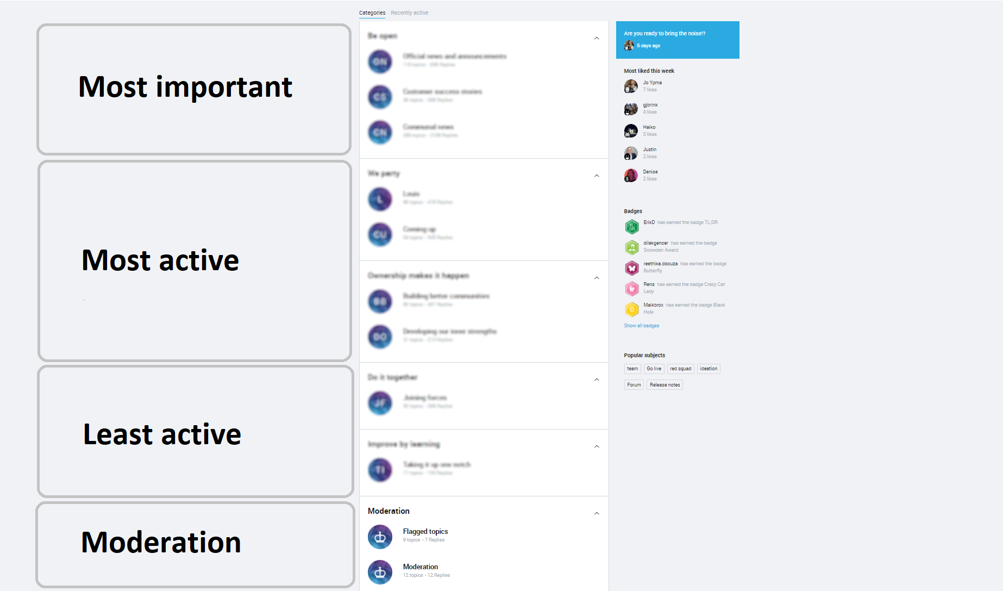Just as you might renovate your apartment from time to time, it’s a good idea to regularly check that the structure of your community is performing well. There are other good reasons to (re)optimize your category structure, e.g. older products are less relevant or new features have been introduced to the community platform (like our parent category pages).
This guide will help you on the way to get your community structure up-to-date so that you know what to look out for in the process.
Getting Started
We’ve put together a template you can use in tandem with this article to help narrow in on your categorization strategy. This template is also attached to this article for your convenience.
When to Review?
We recommend that you do not change the structure of your community too often, especially shortly after launch. If you change things too often, users will get lost and be less active. In the early years of a community, we recommend to do such a review every 6 months, while mature communities should look at their structure on a yearly basis.
Where to Start?
You might be able to easily identify certain categories that are not at all active. However, it’s good to do a full review of all the content in your community so that you don't miss out on anything. You can do this easily by:
- downloading an all-time export of your topics (or for mature communities the past year)
- checking the content dashboard for the last 6-12 months and compare (in the "popular categories"-table) how many topics have been created within the different categories?
How to Review
Within the dashboard, check for over-performing categories and underperforming categories:![]() Over-performing categories
Over-performing categories
Besides a very high level of activity, you might find that within a category there are different classifications of questions / discussions. If you could split the category up in multiple ones and each of them would still be "active", that’s a good sign that there might be room to grow.![]() An active category in a B2C (business to customer) community has at least three activities a day (new comments, new topics etc.). For a B2B (business to business) community this might not be as relevant though, especially if you focus on a Knowledge Base aspect of your community.
An active category in a B2C (business to customer) community has at least three activities a day (new comments, new topics etc.). For a B2B (business to business) community this might not be as relevant though, especially if you focus on a Knowledge Base aspect of your community.![]() Underperforming categories
Underperforming categories
An underperforming category will stand out in a different way: The last activity might have been a few weeks ago, or the overall number of topics is far lower than in all other categories of the same age.
Once you have identified these, it is time to go back to the drawing board. Be as open as possible about what your future community structure should look like.
- Can over-performing categories be split up? Could they maybe also form a completely new parent category on its own?
- Can underperforming categories be removed completely, or integrated in another one? You probably will have to make a tough decision here: Sometimes it feels awkward to have e.g. an Apple and an Android category combined. Don't be too shy to do this however - the goal is to have active categories and therefore such a change might be necessary.
- Think about where these categories should be located. Below you can find an overview of an ideal / default hierarchy of categories on a homepage:
We recommend that you always have a "welcome"/"News and Announcements" category at the top of the list (as it is arguably the most important for your community success).
Once you have figured out which categories should exist after your review (and after you have asked for feedback from colleagues / users), it is a good idea to go through the topic export you created earlier in order to identify if all topics will still have a "home" once your review is done. It is a good test to see if your new categorization makes sense - if this is not the case, you need to go a step back and fix this.
How to combine / separate two categories?
If you decide to combine two categories to one, you will first need to move all the content from one category to the other. Simply select the category you want to move in the topic overview, then you will see a full list of all the content. Select all topics and click in the menu at the bottom on "move to forum" to move it to the new location.
Should you want to split up a category, then you will need to select only the topics which you want to move to a new destination. Depending on the overall size of the category (# of topics) this can take a while. Here some tips:
- If that category has been active for many years, you might want to only move content which is younger than one year (since last activity)
- It is recommended to "hide" the new category which you want to move the content to until you are done. You can set the permissions of that category so that they are not visible to registered users etc.
Deleting a Category
Should you want to delete a category, then first you will have to (re-)move all content from that category. Simply select the category you want to remove in the topic overview, then you will see a full list of all the content. Move this content to a new destination (or delete them), and after that delete the category in the category settings page.
Moving topics to different categories
Simply select the category you want to move in the topic overview, then you will see a full list of all the content. Select all topics and click in the menu at the bottom on "move to forum" to move it to the new location.
Archiving
You can also choose to move individual topics or entire categories into an archive. For that, create a separate parent category called "Archive" and locate it at the bottom of your category list. Then, move the content or the categories into this archive. You can, if you wish, also set up your robots.txt file in a way that these categories are not being crawled by Google any more (read more about this topic here).
Frequently Asked Questions:
Should I ask for (Super) user / internal feedback?
Yes, absolutely! You can either ask them what their ideal community structure would look like, or give them a couple of versions of which they can vote for their favorite one. Stress that you will take their feedback into account however also take your time to explain to your Super users why certain feedback will not result in his/her desired change - Super users can have a very subjective look at your community and you should never forget the "regular" one-time visitor who is looking for information. If you want to take it to the next level, you can also decide to sample a group of newly registered users and ask them for their opinion, so that you also hear what they think of your category structure.
Communication
Don't forget to announce the changes. Users will feel assured that you are invested in the community, and people will appreciate learning more about the reasons of your changes.
Tip: If your users disagree or have other suggestions, confirm that you will consider their feedback, but also explain that you have done your changes for good reasons & for the entire userbase of the community.
Integrations
Make sure to do a review of all the integrations (links to the website, sometimes even content automatically loaded from the community) - it could be that due to the changes they will not work again or that you can offer a better integration now. For a guide to review your integrations, please visit this tutorial: Link
More questions or suggestions about this? please let us know in the comments! 🙂
This article last updated June 23, 2023

